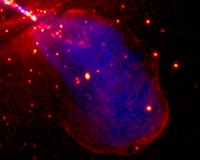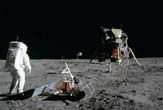
© UnknownThe image shows in red the X-ray emission produced by high-energy particles accelerated at the shock front where Centaurus A's expanding radio lobe (shown in blue) collides with the surrounding galaxy. In the top-left corner X-ray emission from close to the central black hole, and from the X-ray jet extending in the opposite direction can also be seen. Centaurus A (NGC 5128) is the nearest active galaxy to Earth. It is located about 14 million light-years away in the constellation Centaurus. Its structure suggests that it is an example of an elliptical galaxy that has been disrupted by a collision with a smaller spiral galaxy.
A survey by the Chandra X-ray observatory has revealed in detail, for the first time, the effects of a shock wave blasted through a galaxy by powerful jets of plasma emanating from a supermassive black hole at the galactic core.
The observations of Centaurus A, the nearest galaxy that contains these jets, have enabled astronomers to revise dramatically their picture of how jets affect the galaxies in which they live. The results will be presented on Wednesday 22nd April at the European Week of Astronomy and Space Science in Hatfield by Dr. Judith Croston of the University of Hertfordshire.
A team led by Dr. Croston and Dr. Ralph Kraft, of the Harvard-Smithsonian Center for Astrophysics in the USA, used very deep X-ray observations from Chandra to get a new view of the jets in Centaurus A. The jets inflate large bubbles filled with energetic particles, driving a shock wave through the stars and gas of the surrounding galaxy.






